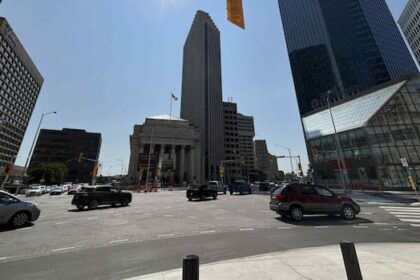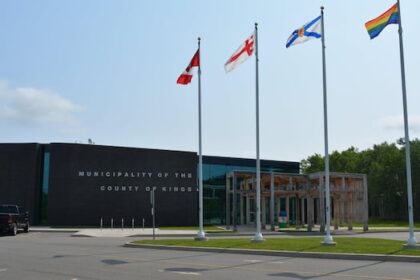Last week, a member of Ontario’s Doug Ford government touted the importance of access to nature to his colleagues. Andrew Dowie, MPP for Windsor-Tecumseh, is spearheading Bill 26, new legislation that would amend the provincial parks law to include two new classes of parks: urban and adventure. The primary purpose is to facilitate the creation of a new provincial park east of Toronto in Uxbridge by connecting Greenbelt lands with rehabilitated private quarries. The legislation will also aim to create other urban and adventure parks like it. The bill is currently being reviewed by a government committee, which heard from members of the public this week. Dowie, who serves as the parliamentary assistant to the minister of the environment, conservation and parks, told his colleagues the bill codifies the idea that a growing Ontario needs different kinds of natural spaces. “Urban parks make nature accessible where Ontarians now live in growing towns, expanding cities and suburban communities,” he told the committee on Nov. 17. “Urban parks don’t replace traditional provincial parks. They simply acknowledge that in a province of 15 million people, proximity matters.” And in truth, natural spaces are getting farther and farther away from urban centres, as those centres sprawl farther and farther out. Adventure parks, he said, “bring people into nature in different ways,” by encouraging outdoor activities like cycling, paddling, climbing and backcountry trekking, along with newer ventures like pickleball and Pokémon GO. These kinds of parks “give communities new ways to connect people with natural spaces and truly build that appreciation for our biodiversity and for ecological protection,” he said. Parks that exist close to or in city centres, like the Greenbelt Eastern Parkway outside Ottawa, pictured above, can provide important opportunities for urban dwellers to experience nature near their homes. Photo: Spencer Colby / The Narwhal On paper, it makes sense. Over the last few decades, Ontario has rapidly grown, having doubled in population since 1971. That growth has increased the need for and stress on natural spaces, which offer respite for humans and wildlife in so many ways: preserving natural areas lowers stress levels for those who visit them, reduces pollution, protects biodiversity, mitigates flood risk and more. But the proposal also comes from a government that continues to expend waterfronts and natural spaces in favour of development and industry. There’s a laundry list of government actions that have put parks and conservation spaces under threat in recent years — everything from the Greenbelt scandal to a bevy of changes to conservation authorities that manage watersheds and public green spaces in Ontario. The Ford government is removing land from parks to make room for development Bill 26 is the Ford government’s second amendment to the Provincial Parks and Conservation Reserves Act in several days, picking away at the permanent protection of the lands it governs. In addition to now including two new kinds of parks, the act is also being changed to remove lands from three existing provincial parks to make room for tourism and a highway. The government is proposing to remove slivers of land from Grundy Lake and French River provincial parks in northern Ontario to facilitate the widening of Highway 69. It’s also planning to remove land from Wasaga Beach Provincial Park — more than 60 per cent of which is beachfront that also serves as nesting area for endangered piping plovers — and give it to the town to help boost the local economy with tourism-specific development. The bill carrying this change is being put to a final vote this week. The Ford government insists these changes are specific in their scope and limited in their impact because, as Dowie said, the Progressive Conservatives value nature — at least, sometimes. Around the same time Bill 26 was tabled, the Ford government also put forward a proposal to amalgamate 36 conservation authorities — agencies unique to Ontario that manage watersheds and reduce the risk of flooding — to seven, leaving unclear the state of the thousands of acres of land these unique agencies manage to minimize flood risk and boost access to nature. Though how this will all play out remains very unclear, there is a strong precedent for Ford meddling with the authorities’ power. In recent years, conservation authorities have been told to audit their lands to find surplus areas for potential development and told the environment minister can overrule their decisions to not allow development permits (or allow them, but that’s not really on brand. Remember minister’s zoning orders or MZOs?). The Ford government is planning to remove a portion of the popular Wasaga Beach from the province’s provincial parks, giving it to the town to boost the local economy. The move has sparked backlash from conservationists and nature lovers. Photo: Carlos Osorio / The Narwhal Plus, the government has watered down the rules that protect wetlands and waterways in these natural spaces, and has exempted major projects, like the Ontario Place redevelopment on the Toronto waterfront, from environmental assessments.And then there was the Greenbelt scandal, an effort to forego the protection of parcels of farmland and natural spaces for development. ‘Nature should be part of everyday life’ — but for how long? Cumulatively, the Ford government’s approach to nature is both confusing and contradictory. It’s valuable, until it’s in the way. And it’s worth protecting as long as people’s place in it is clearly defined. Natural spaces for the sake of nature — not to mention carbon sequestration, flood mitigation and the many other ecosystem services it provides — isn’t a goal for this government. The proof is in the literal weeds: in the time that this government has been in office, the auditor general has found there is no clear strategy for expanding the province’s natural areas, not enough staff in place to properly protect them and very little funding allocated to enable either. And even when action makes sense, its execution doesn’t. On Friday, the government announced a $4.75-million investment to rebuild and upgrade Samuel de Champlain Provincial Park in Mattawa, Ont., and turn it into a “year-round destination.” The park was devastated by a June storm, trapping campers and clearing swaths of forest. “The storm was one of the most severe events Ontario Parks has ever faced,” Environment Minister Todd McCarthy said in his announcement. What he didn’t say was that scientists predict such intense storms will increase in frequency due to global warming fuelled by the burning of fossil fuels. Rebuilding the park is good, but rebuilding it by prioritizing tourism over the climate resilience of such natural areas means they won’t last. Bill 26 may be designed with good intentions, and Dowie certainly said all the right things at committee. “It will help ensure that access to nature is not to be determined by persons, postal code or income, but by the shared belief that nature should be reachable, welcome and meaningful, in effect democratic,” he told his colleagues. “Nature should be part of everyday life, not an occasional privilege, not one controlled by private landowners all the time, but truly a regular experience.” No one would disagree — including beachgoers at what used to be Wasaga Beach Provincial Park. But even if the Ford government facilitates the creation of new urban and adventure parks and fixes up damaged ones, their success depends on the protections that are offered to every park in the province. And when it comes to using the power of the law to ensure nature’s protection, the Ford government has proved more adept at bulldozing through it. Recent Posts How does the Ford government really feel about parks? Nov. 25, 2025 6 min. read The Ford government wants to build urban and adventure parks, even as it moves to… A conservation economy in Nunavut moves ahead with $270-million investment Nov. 24, 2025 5 min. read Qikiqtani Inuit Association announce implementation of landmark agreement to protect almost one million square kilometres… Fast track to where? Carney’s major projects list stirs up emotions, and not much else Nov. 21, 2025 9 min. read Alberta is pushing for a pipeline that doesn’t exist to be included on a list…
How does the Ford government really feel about parks?












